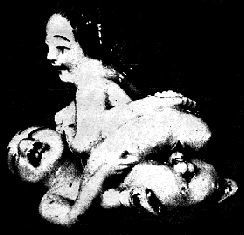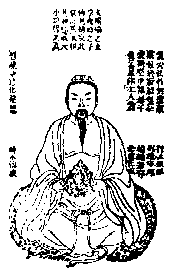
Religious Taoism
Taoist Practices and Beliefs
During this time there began to develop a pantheon of TAOIST DEITIES which were often venerated as gods.
So prominent were astrology, alchemy and divination in this stream of Taoism that it had veered away from philosophy to occultism. This movement was sometimes known as Huang-Lao, after the legendary Yellow Emperor, Huang-ti and Lao Tsu.
From this form of Taoism emerged very strong alchemical currents as Taoist practitioners (much like Western mystics a millennium later) at the court of Shih Huang-ti of the Qin (Ch'in) dynasty (221-207 BC) tried to cultivate powers that would transform base metals to gold, and hence would serve as a metonym for the transformation of human qualities to the transcendent. These practitioners were also acclaimed as spirit mediums and experts in levitation.
 Lovers Practicing Taoist 'Hovering Butterflies' Posture: Porcelain,
Ch'ing Dynasty.
Lovers Practicing Taoist 'Hovering Butterflies' Posture: Porcelain,
Ch'ing Dynasty.
Among the important features of Taoist religion were the belief in physical immortality, alchemy, breath control and hygiene (internal alchemy). It supported a pantheon of deities, including Lao Tzu as one of the three 'Supreme Ones'. The Taoist liturgy and theology was much influenced by Buddhism. Its scriptures, the Tao-tsang, consist of over 1,400 separate works totaling more than 5,000 chapters.
Of special significance to these mystics were the colour red (symbolizing the furnaces of the alchemists), the Manchurian Crane with its red spot of divinity in its crown, and the compound cinnabar (composed of mercury and sulphur) which could be transformed into a silvery liquid; and back again into a solid.
There is considerable evidence that this religious Taoism came to take on many 'Tantric' elements, in which the worship of yin-yang takes on a distinctly sexual and erotic form. The interplay of yin and yang elements is represented, and celebrated, as a sexual union. There are some scholars who, in fact, believe that the Tantric schools, which later were absorbed into Buddhism, evolved first as Taoist ones.
Taoist Sects
- The Heavenly (or Celestial) Masters sect, founded in West China in the second century A.D. It was founded by Chang Tao-ling (AD 34?-156?) who reputedly possessed remarkable healing powers. It advocated faith healing through the confession of sin and at one time recruited members as soldiers and engaged in war against the government.
-
In the 11th century, the sect obtained a large tract in Jiangxi province that remained an important Taoist center until 1927. The sect still flourishes in Taiwan and continues to pay homage to Zhang Daoling, who is regarded as immortal.
-
The Supreme Peace sect, also founded in the second century A.D., adopted practices much like those of the Heavenly Master sect and launched a great rebellion that went on for several years before ending in 205 A.D.
-
The Mao-shan (Mount Mao) sect, founded in the 4th century, introduced rituals involving both external and internal alchemies, mediumistic practice, and visionary communication with divinities.
-
The Ling-pao (Marvelous Treasure) sect, also founded in the 4th century, introduced the worship of divinities called T'ien-tsun (Heavenly Lords).
-
The Ch'uan-chen (Completely Real) sect was founded in the 12th century as a Taoist monastic movement.
History of Religious Taoism
 The Immortal Soul of the Taoist Adept.
The Immortal Soul of the Taoist Adept.
Late in the Han dynasty (beginning of the 3rd century A.D.) a branches of Taoism, such as Yellow Turban Movement and the Celestial Masters Sec, , became a popular revolutionary cults. The former, led by the three Chang brothers, promised immortality to ordinary people. Hundreds of thousands of destitute people flocked to their banner, holding great public gatherings, confessions of sins and even uninhibited orgies. Although the movement fell apart, it was one of the key factors that de-stabilized the Han dynasty and lead to its downfall.
However, even in the time of the Six Kingdoms (220 to 618 A.D.) Taoism continued to attract many refugee intellectuals, fleeing from the barbarians in the North.
Particularly important to the development of Taoism in China was the rein of the Emperor Li Lung-chi (a.k.a. Hsuan Tsung) who ruled for 44 years and was a fervent adherent of Taoism. Deeply absorbed in its study he tried to create a Taoist state in which capital punishment would be abolished and animals would be treated humanely. He established hospitals for the sick and poor and was an accomplished musician, equestrian, calligrapher and astronomer.
A true mystic Li Lung-chi once had a vision of Lao Tsu who told him where to find a true likeness of him. The image was, in fact, discovered and replicas of it were made and installed in temples across the realm. He also told his ministers that once while burning incense in a shrine he had been wafted up to Heaven.